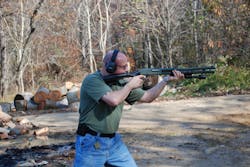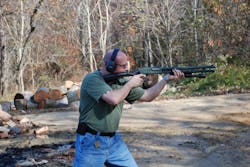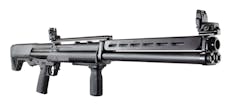The Law Enforcement Shotgun: Tried, True & Not Going Away
With the first patent on a slide action—or pump action—weapon having been issued in 1854, it’s safe to say that the pump action shotgun has been around for quite some time.
Long known as a good hunting tool, its value as a self-defense weapon was a given. When you add in the versatility of the weapon thanks to the wide variety of ammunition available, it maintains its value in the law enforcement armory. Despite this, the issue and use of it in law enforcement dropped off somewhat back at the beginning of the 21st century.
Why?
After the Columbine school attack in 1999, many agencies made the move to put patrol rifles into their units. Instead of adding another firearm to the patrol vehicle, they swapped out the shotgun for a rifle. This reduced their initial cost (or so they thought) and in many cases removed the long gun in the cruiser from public view. For many agencies, instead of having the shotgun in the lock in the passenger compartment, the patrol rifle went in a case in the trunk. Some agencies did it correctly and simply added the patrol rifle to the shotgun already being carried, thereby expanding the response capabilities instead of swapping one for another. In light of the shotgun’s variety of capabilities, swapping a shotgun for a rifle is actually rather limiting in response options.
Let’s take a quick look at some of the models of shotgun that are common for police work in addition to some of the newer or more unique models that we should see grow into greater use in the future. After that, we’ll take a look at a few of the ammo options that expand mission capability.
Shotgun legacies and newcomers
Remington 870: In service since its invention in 1950, the Remington 870 comes in a wide variety of configurations and there are many aftermarket accessories available for it. It has been carried and used not only by law enforcement but also by a number of military units around the world, having seen combat action in Vietnam, Lebanon and Iraq. Reports indicate that more than 11 million of them have been manufactured with at least nine unique configurations, each meant for a specific mission use. It has been manufactured in 12 gauge, 16 gauge, 20 gauge and .410. The non-customized barrel lengths produced have measured from 14” to 30” with the most common length found in police cars being either 18.5” or 20”. While many of these shotguns were produced with just a front bead sight, many also were produced with rifle sights. With properly mated ammo, they are capable of accurate shots out to 50 yards with a smoothbore barrel.
Mossberg 500: Perhaps the second most issued or used pump action shotgun, the Mossberg 500, and its variants, have been in production since 1960. Like the Remington 870, the Mossberg hasn’t seen action just in the hands of law enforcement. The Mossberg has seen combat action with military units in the Persian Gulf War, Lebanese Civil War, Iraq War and others. The Mossberg 590, specifically built for ease of cleaning in the field, has been issued to many front line combat military units and has been used for breaching as much as anti-personnel work. The Mossberg 500/590 remains a popular shotgun and can often be found in a police vehicle’s shotgun lock or in the trunk.
Benelli M4: Perhaps one of the rare semi-automatic shotguns that has been found in law enforcement use, the Benelli M4, using the nomenclature of M1014, was adopted by the U.S. Marine Corps in 1999 as a result of winning the Joint Service Combat Shotgun contract. Since that time, Benelli Tactical has become a division of Beretta’s Law Enforcement division. Available in three configurations (the M4 Entry with a 14” barrel, the M4 with a 18.5” barrel and the Military model the M1014), the Benelli serves with a variety of law enforcement, government and military agencies.
Before we look at the next shotgun on the list, let’s quickly consider the limitations that usually exist for a shotgun in a police vehicle.
- Size. Like a patrol rifle, the shotgun is usually 30” or more in length if it has a standard shoulder stock and 18.5” or 20” barrel. It’s not usually foldable or flexible in any way.
- Capacity. While it’s hard to conceive of a situation where five rounds of 12g wouldn’t be enough to defeat a target, there are tactical and crowd situations where “never enough” applies. Even with extended magazine tubes holding 7 or 8 rounds, there is still a limited capacity and relatively slow reload.
As with so many things in law enforcement, any added training requirement has an attached increase in equipment (ammo) and labor (training hours) cost. Those increased costs are all too easy for administrators to use when citing why they don’t upgrade to a new weapon.
The other thing you’ll often hear is, “Why replace what we have? Those shotguns are still serviceable and work just fine.” There is no arguing that rationalization. It’s true. That acknowledged, the KSG allows an officer to carry twice as much ammo in a more compact overall package. That is something that needs to be taken into consideration, especially in light of the previous “never enough” condition put on ammo capacity. Just recently, perhaps in response to some of these arguments, Kel-Tec released the KSG in a new single-magazine-tube configuration. This slimmer model is just as compact as the KSG, incorporates an optional carry handle and is lighter than the original. For those administrators who are worried about training curve and/or the added capacity of 12g ammo, this shotgun answers the concerns while incorporating the easier to store and carry size of the bullpup design.
A look at less lethal
Now let’s consider the ammunition options for the 12g shotgun. It should be noted up front that some types of less lethal ammo will not function in a semi-automatic shotgun. It is the responsibility of the agency or shotgun owner to test and ascertain whether less lethal is reliable in their weapon(s) or not.
Because of the payload size available for a 2.75” 12g shotgun round (much less those with 3” or 3.5” capacities), the variety of payload is vast. Many pump action 12g shotguns are equipped with blaze orange stocks to designate them as less lethal-only weapons. That less lethal ammo, available from many manufacturers, includes rubber bullets, rubber BBs, OC (pepper spray) blasts and more. There is training required for using less lethal ammo in 12g shotguns so agencies must ensure all proper policies are written and disseminated.
With a history now dating well over 160 years, there’s no reason to think that shotguns are going away any time soon. With the constant development of new technologies and capabilities, the versatility of 12g shotguns should continue to expand. With that thought in mind, we’d encourage you not to write yours off in your arsenal.



